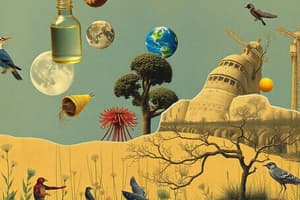Podcast
Questions and Answers
How do abiotic components contribute to the biosphere?
How do abiotic components contribute to the biosphere?
Abiotic components like land, water, and air provide the physical and chemical basis necessary for biotic components to survive and interact within the biosphere.
Explain how the interdependence of countries leads to globalization.
Explain how the interdependence of countries leads to globalization.
When countries rely on each other for goods and services they cannot produce themselves, international trade increases. This interconnectedness and exchange on a global scale results in globalization.
Give an example of how natural and human-made components interact within an environment.
Give an example of how natural and human-made components interact within an environment.
A forest (natural component) provides timber that is used to build houses (human-made component); The forest also absorbs carbon dioxide, a byproduct of human activity.
How does international trade impact the availability of resources in different countries?
How does international trade impact the availability of resources in different countries?
Describe the relationship between biotic components and the biosphere.
Describe the relationship between biotic components and the biosphere.
Explain why the exchange of goods is essential for interdependence between countries.
Explain why the exchange of goods is essential for interdependence between countries.
How do human-made components affect the natural components of an environment?
How do human-made components affect the natural components of an environment?
How do natural components contribute to the production of commodities like car tires and chocolate?
How do natural components contribute to the production of commodities like car tires and chocolate?
How does globalization affect cultural diversity?
How does globalization affect cultural diversity?
Explain how the concept of interdependence applies to the relationship between urban and rural areas.
Explain how the concept of interdependence applies to the relationship between urban and rural areas.
Flashcards
Natural Components
Natural Components
Natural components are created by nature, they include plants, animals, land, air and water.
Biotic Components
Biotic Components
Living things such as plants, animals, and people.
Abiotic Components
Abiotic Components
Non-living things such as land, water and air.
Earth's Domains
Earth's Domains
Signup and view all the flashcards
Human-made components
Human-made components
Signup and view all the flashcards
Interdependence
Interdependence
Signup and view all the flashcards
Globalization
Globalization
Signup and view all the flashcards
Study Notes
Natural Components
- Natural components are created by nature
- Plants, animals, land, air, and water are a few examples of natural components
- Natural components make up the natural environment
- Natural components are divided into biotic and abiotic types
Biotic Components
- Living things, including plants, animals, and people, are biotic components
- Biotic components make up the biosphere
Abiotic Components
- Non-living things like land, water, and air are abiotic components
- Abiotic components comprise the three main domains: the lithosphere (land), hydrosphere (water), and atmosphere (air)
Human-Made Components
- Human-made components are created by people
- Houses, roads, factories, and transport are examples of human-made components
- Human-made components make up the human-made environment
Interdependence
- Interdependence is the dependence between two or more people, things, countries, or regions
- Most countries are interdependent for the exchange of goods, that they cannot produce or consume themselves
- Interdependence among different countries strengthens through international trade, leading to globalization
- Globalization allows people in different countries to fulfill many of their needs
- Car manufacturers in Europe use tires from South America and chocolate companies source ingredients from tropical regions in America and Africa
- Other examples of international goods include merino wool and petroleum
Studying That Suits You
Use AI to generate personalized quizzes and flashcards to suit your learning preferences.




